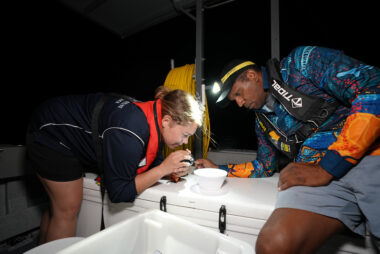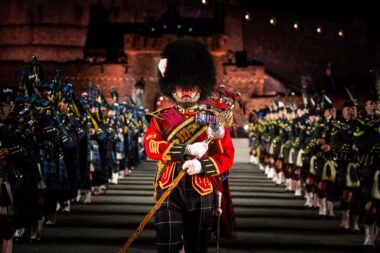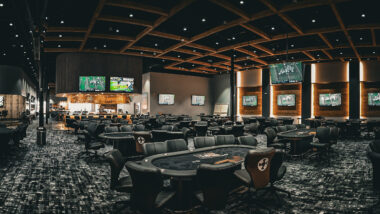Monday 12 August
Highlights from day 3 of National Science Week
Researchers, experts, and other interesting people available for interview around the country.
ACT: Meet the inventor making steel from old tyres
SA: Giant wombat, 2.5 metre kangaroo, Tasmanian tigers, and cool caves – online, via Naracoorte
VIC: Inside the lab of ‘The Man Who Invented Vegemite’ – Beaufort
TAS: Wired for sound: bugging bats, bitterns, and other animals NASA’s $23m space dunny
NSW: Dark matter on the move
NT: NASA’s $23m space dunny – the orbital outhouse!
TAS: Where the krill are going, and the whales are following – online
National: Rare lunar rainbow makes Top 10 ‘amazing things to see in the night sky’ by public vote
Read on for more on these, including direct event contact details.
Also today:
- WA: Murdoch University ecologist explores the Miyawaki method to make forests in cities
- VIC: Find out how mathematicians are helping the planet
- QLD: Students build rockets, explore wind power and find out about engineering careers, in Cairns.
Coming up tomorrow:
Counting koalas; quantum future; space entrepreneur; and find live at The Love Lab – see a preview of Tuesday’s highlights.
National Science Week 2024 runs from 10 to 18 August.
Visit ScienceWeek.net.au/events to find more stories in your area.
Media centre here. Images for media here.
General Science Week media enquiries: Tanya Ha, [email protected] or 0404 083 863
More about the event highlights
Making steel from old tyres – Parkes, ACT
Scientia Professor Veena Sahajwalla invented technology that uses recycled tyres in steel production.
She and her team also invented an e-waste microfactory that harvests metals from old laptops, circuit boards, and smartphones, and technology that makes ceramic tiles and kitchen benchtops from waste clothes and glass. Now they’re targeting plastic, turning hard plastics into feedstock for 3D printing.
Veena will share her vision for a sustainable future at the annual Ann Moyal Lecture at the National Library of Australia. Veena is director of the Centre for Sustainable Materials Research & Technology at UNSW and heads the ARC Industrial Transformation Research Hub for ‘green manufacturing’.
Monday 12 August. Event details: www.scienceweek.net.au/event/ann-moyal-lecture-scientia-professor-veena-sahajwalla/parkes
Veena Sahajwalla is available for media interview.
Media enquiries: Stuart Snell, [email protected] or 0416 650 906.
Australia’s Moonbow connection: rare lunar rainbow makes Top 10 ‘amazing things to see in the night sky’ by public vote – Online
The wild card entry of a Moonbow in a national poll asking, ‘What’s the most amazing thing you’ve seen in the night sky?’, comes as a welcome surprise for Australian National University (ANU) astrophysicist and cosmologist, Dr Brad Tucker.
“I’ve never seen one, but it's cool that people think a Moonbow is special because this is a great combination of the Moon and Earth,” says Brad of the night sky phenomenon that occurs when light from the Moon is refracted through water droplets in the air.
“To have any chance of seeing a Moonbow, you’ll need a full or nearly full Moon that is low enough in the night sky, so its light interacts with rain, similar to the Sun. The best place to see one is near a waterfall, where clouds – and urban light pollution – are less likely to block out the Moon’s natural light.”
But is a Moonbow the #1 thing Australians will miss seeing in the night sky as light pollution increasingly out-glows the Moon and stars?
ABC Science invites you to cast your vote in the final round, before the winner (from the Top 10) is announced on Friday 16 August.
The Top 10 contenders are:
Vote now: www.abc.net.au/nightsky
This National Science Week, the ABC also invites you to:
- explore solutions to light pollution using an interactive;
- take part in a separate online ANU survey of the Milky Way’s visibility; and
- stargaze with ABC Radio National’s Night Sky LIVE (Thursday August 15, 8-9pm AEST, on RN and the ABC Listen app), when BIG IDEAS Presenter Natasha Mitchell broadcasts from the rooftop of ABC Melbourne.
Media enquiries: Shelley Thomas, [email protected] or 0416 377 444.
Available for interviews: Brad Tucker, astrophysicist and cosmologist at Mt Stromlo Observatory, ANU;
Marnie Ogg, founder of the Australasian Dark Sky Alliance ; Fred Watson AM, Australia’s Astronomer at Large; Therésa Jones, evolutionary and behavioural ecologist, University of Melbourne; Sheryn Pitman, project lead, Australia’s first International Dark Sky Community, Carrickalinga, SA; Carol Redford (aka Galaxy Girl), founder and CEO of Astrotourism WA.
Breakfast in a petri dish: inside the lab of ‘The Man Who Invented Vegemite’ – Beaufort, VIC
Vegemite caviar on toast? 101 years after its invention by preeminent scientist and food technologist, Dr Cyril Callister, the iconic Aussie spread that’s already been launched into space and proven to conduct electricity is set to fuel a new class of scientific discoveries.
Inaugural Cyril Callister Foundation Scholarship winner Samuel Varjabedian – a future microbiologist undertaking his honors on reptile-related salmonella at Ballarat’s Federation University – will switch focus to experiments using Vegemite to celebrate the launch of Cyril’s Lab. A replica 1923 science space at Cyril Callister Museum.
Vegemite caviar is one of the experiments adapted for use to inspire young scientists. Samuel will also demonstrate how the spread conducts electricity on a breadboard circuit connected to a lightbulb.
Monday 12 August: www.scienceweek.net.au/event/the-man-who-invented-vegemite-cyrils-lab-launch/beaufort/
Media enquiries: Libby Callister, [email protected] or 0418 151 685.
Giant wombat, 2.5 metre kangaroo, Tasmanian tigers, and cool caves – online, via Naracoorte
Naracoorte Caves is home to an exquisitely preserved giant wombat, a 2.5 metre kangaroo, marsupial lions, giant monitor lizards, Tasmanian tigers, and other megafauna fossils. It’s one of the largest and oldest fossil sites in the world, celebrating the 30th anniversary of its World Heritage listing this year.
Meet the megabeasts and the scientists who study them through webinars presenting the latest discoveries in the caves, livestreamed from within the caves themselves. Significant discoveries include finding new species of animals and understanding how mammals respond to climate change.
Webinars include:
Detectives in Time (Monday 12 August): exploring what palaeontologists do
Naracoorte's Megafauna Revealed (Monday 12 August): renowned palaeontology Dr Liz Reed shares her knowledge of Australia's extinct megafauna like the marsupial lion Thylacoleo carnifex and the largest marsupial known Diprotodon optatum.
Learn about the Southern Bent-wing (Tuesday 13 August): Southern Bent-wing Bat researcher Nicola Bail on this critically endangered species of bat
All about the 'Tites and 'Mites (Tuesday 13 August): learn more about speleothems, such as flowstone, columns, drapery, stalagmites, stalactites and straws.
History of the Naracoorte Caves (Wednesday 14 August): Learn about early scientific discoveries and developments in the caves, from early research by Julian Tenison-Woods, historical uses of the caves post-European colonisation, and development by early park managers and the eventual discovery of significant fossil deposits in Victoria Fossil Cave.
Beyond the Boundaries – Geology of the Naracoorte Caves (Wednesday 14 August): geologist Ian Lewis takes a trip back in time to when the Naracoorte Caves didn't exist.
Media enquiries: Thoman Shortt, [email protected]
Wired for sound: bugging bats, bitterns, and other animals – Devonport, TAS
How do you find where the wild things are at night? Through the noises they make, from the ultrasonic chirps of nine elusive bat species to the booms of the rare and mysterious Australasian bittern.
Bookend Trust are looking for people to join the CallTrackers project, using state-of-the-art sound recorders to capture nocturnal wildlife calls, helping scientists and conservationists track changes in wildlife numbers and habitats over time.
‘Discover CallTrackers’ workshops during Science Week will show you how to get involved in acoustic wildlife monitoring, book a survey spot, borrow and use recorders, upload your recordings to the Acoustic Pipeline website, and make identifications. Trained volunteers will go to field from September to March around Tasmania.
Devonport: Monday 12 August. Event details: www.scienceweek.net.au/event/discovering-calltrackers-2/devonport/
Other CallTrackers workshops around Tasmania.
Media enquiries: Clare Hawkins, [email protected] or 0400 889 336
Dark matter on the move – touring Australia’s cities and regions; Sydney today
Meet dark matter hunters and quantum experts at events across Australia.
The National Quantum & Dark Matter Road Trip will tour pubs and schools in cities and towns around Australia starting off at the University of Queensland in Brisbane, then heading to Dalby, Cloncurry, Ballarat, Sydney, Perth, Kununurra, Broome, Dandenong, Melbourne and many other places.
Dark matter accounts for 84 per cent of all the matter in the Universe… but we don’t yet know what it is. Australia is a key player in the quest to find out.
Quantum technologies are crucial in the hunt for dark matter, and they’re already used in smart phones and cars, medical imaging, manufacturing, and navigation. But today’s technologies capture only a small fraction of the potential of quantum physics.
Today at the University of Sydney, Camperdown: www.scienceweek.net.au/event/national-quantum-and-dark-matter-road-trip-6/camperdown/
Media enquiries: Fleur Morrison, [email protected] or 0421 118 233.
Multiple experts involved with different legs of the tour are available for media interviews, including dark matter enlightener Jackie Bondell and particle physicist Ben McAllister.
NASA’s $23m space dunny – Darwin, NT
Do loos flush in space? Not quite. In zero gravity they operate with suction, like a vacuum cleaner, requiring intense astronaut pre-training.
Goggle-up and join Darwin local, Debbie Hyder – a former circus performer and unicycle world champion who now runs Amazing XR – on an ‘Outback to Outer Space’ VR field trip.
From Ubirr Rock, Kakadu National Park, to the International Space Station (including a peek at NASA’s $23 million dunny, dubbed ‘the orbital outhouse’).
Monday 12 August (Darwin City Library) & Tuesday 13 August (Casuarina Library): www.scienceweek.net.au/event/outback-to-outer-space/darwin
Media enquiries: Debbie Hyder, [email protected] or 0427 615 097
Where the krill are going, and the whales are following – online via TAS
Paige Kelly is back from Antarctica where she’s worked out where the wild things are and where they’re going as the oceans warm. She’s an expert in cold-loving krill, and other marine species.
The Southern Ocean is warming three times quicker than any other sea, making it too hot for the shrimp-like krill that whales usually eat, but perfect for other species like the jellyfish-like salps, which are blooming like weeds. Join Paige in this cartoon-based talk to learn about where the wild things are going in a warming ocean.
Monday 12 August. Event details: www.scienceweek.net.au/event/species-that-like-it-hot-uctv-alive-for-kids-webinar-with-dr-paige-kelly/
Media enquiries: Tess Crellin, [email protected] or 03 6226 7536.
About National Science Week
National Science Week is Australia’s annual opportunity to meet scientists, discuss hot topics, do science and celebrate its cultural and economic impact on society – from art to astrophysics, chemistry to climate change, and forensics to future food.
First held in 1997, National Science Week has become one of Australia’s largest festivals. Last year about 2.7 million people participated in more than 1,860 events and activities.
The festival is proudly supported by the Australian Government, CSIRO, the Australian Science Teachers Association, and the ABC.
In 2024 it runs from Saturday 10 to Sunday 18 August. Event details can be found at www.scienceweek.net.au.
Paige Kelly is available for media interviews.




